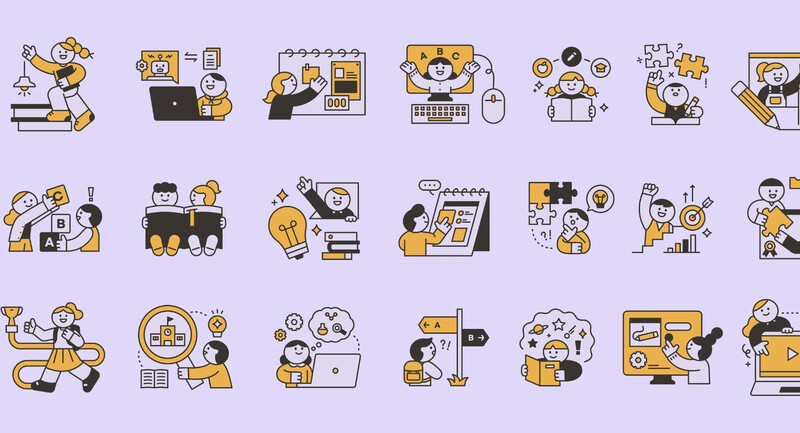I really want to be an astronaut when I grow up. I know a lot about the space station." Jacob looks up from his book, Eyewitness: Space Exploration (DK Children, 2004), during my visit to his 5th grade classroom at James Lewis Elementary School in Blue Springs, Missouri. I have just taught a lesson in which I explored with students the concept ofschema—relevant prior knowledge and experience that readers use to comprehend text more deeply. Now I'm conferring with students individually as they apply this comprehension strategy in their independent reading.
I'm not surprised by the rather superficial nature of Jacob's response to my question about how the book he's reading relates to his own life. Several years ago, I might have said, "Great connection, Jacob. Mark it on a sticky note and keep going!" Not any more. Instead, I ask him to give me a moment while I consider how to respond to him. I want to actually teach him something that will be valuable to him as a reader, and I'm going to take my time to consider the most effective approach.
A Bit of History
In the early 1990s, I studied research showing that students who are taught particular cognitive strategies (see "Key Reading Comprehension Strategies," p. 71) are likely to comprehend text more deeply. With colleagues at the Denver-based Public Education and Business Coalition, I began to teach these comprehension strategies explicitly, thinking aloud with students to show how a proficient reader uses the strategies and then gradually encouraging the students to use them independently (Pearson & Gallagher, 1983). After experimenting with strategy instruction at a wide range of grade levels, I concluded, as did many researchers, that comprehension strategy instruction has a significant and lasting effect on students' understanding (Keene & Zimmerman, 1997/2007; Pearson, Roehler, Dole, & Duffy, 1992; Pressley, 2002).
Since then, I have had the opportunity to work with and observe teachers implementing strategies instruction in classrooms throughout the United States. Today, in schools like James Lewis Elementary, I see teachers extending our original ideas about comprehension teaching in exciting new directions.
Walking down the hallway at James Lewis, you see evidence everywhere that students' work is valued, their interests and passions celebrated. Each grade level has created its own reading area in the hallways where students can read under the soft light of a lamp, meet with their book clubs, or practice reading with senior citizen volunteers. Individual classrooms also contain comfortable spaces in which to read and talk.
The classrooms and public spaces at this school make me want to grab a book and join the students who are deeply engaged in reading, thinking, and discussing. Even more intriguing than the school's visible physical environment, however, are the invisible components of its success story. The beauty of this school is the level of engagement and intellectual challenge that are evident in its classroom interactions.
Three Scenarios for Reading Comprehension
As I consider how to proceed with Jacob, I reflect on three types of comprehension instruction that a teacher might use with students. In traditional comprehension instruction, Jacob might be part of a small group of students who read the same text. The teacher might ask Jacob and the others in the group questions to assess their recall of the main idea and some supporting details; chances are, the teacher would already have the "right" answers in mind. In this scenario, Jacob and his classmates aren't really being taught to comprehend better; they're being assessed to determine whether they have read the text and what they recall from it shortly thereafter. In a classic study, Durkin (1978/1979) showed that the vast majority of what passed for comprehension "instruction" was really assessment.
The second approach is a variation on comprehension strategy instruction. Jacob would be taught (at least it's not just assessment!) to use a strategy such as questioning or schema to make text-to-self, text-to-text, and text-to-world connections. The teacher would confer with Jacob alone or in a small group to get the students to share their questions or connections. Jacob would perhaps share that he "wants to be an astronaut" or has "read another book about space" or "knows a lot about the space station"—text-to-self, text-to-text, and text-to-world (solar system?) connections, respectively. He might make connections, but he wouldn't necessarily learn anything about how to call on his relevant prior knowledge to understand a new text more completely and lastingly.
There is a third option—one that represents a new horizon in comprehension instruction. In this scenario, strategies aren't treated as ends in themselves, but as tools to enhance understanding. We want to push Jacob to do more than just articulate how his prior knowledge and experiences help him understand the text. We also want him to connect and store new information in association with what he already knows, creating a more complete picture of the topic in his long-term memory. Perhaps most important, we want him to transfer the kind of thinking he is using today to new texts and learning contexts in the future.
Putting Scenario Three into Practice
"Okay, Jacob," I say, resuming the conference after a few moments of silence, "you're saying that you have a connection to this text because you really want to be an astronaut when you grow up and you know a lot about the space station." I always try to restate the student's response so that he or she has a chance to hear it again and reflect on it more. "Now I have an important question to ask. Do you have additional schema that helps you understand this book?"
He looks up, clearly surprised, and appears to be thinking "I just told you my connection. Isn't it time for you to move along?"
"I just mean, Jacob, that I'm interested in other schema you may have and how it may help you understand this book better."
Jacob glances back at the book and says, "That's all." It's an almost automatic response, but I'm not going to accept it. I use one of my favorite responses to help him buy some time to think: "I know you don't have more schema, Jacob, but if you did, what would it be?"
He looks at me as if he wonders whether I'm hard of hearing, but I just smile. This time, he turns back to study a section in the book that describes astronauts' sleeping bags. He glances up at me and back at the page several times. I wait and resist the urge to bail him out with a leading question or idea. Sometimes I have to bite my tongue, but it's always worth the wait.
Finally, he says, "Well, I was thinking about my sleeping bag at home and how if I had it in space, it would just be floating around and I would bang into stuff because of no gravity. I couldn't get how come they aren't just floating around in their sleeping bags, so I had to reread this part, and then I looked at these pictures and I started to understand that their sleeping bags are totally different. They're made out of different material that's only for space; they're anchored to the beds. Then, I started thinking about how people figure this stuff out—how they make new stuff like a sleeping bag for space.…" Jacob goes on at some length, and he reveals an impressive understanding of some of the problems scientists have had to solve to make life in space possible.
Jacob is beginning to think beyond the book. He's exhibiting two of the common outcomes of applying comprehension strategies to informational text: (1) understanding the context and conditions that lead to important discoveries in the scientific, technological, or social scientific world; and (2) developing a sense of the elements of a problem and the necessary steps to solve it. Using comprehension strategies in reading fictional text commonly leads to a different set of outcomes—for example, experiencing empathy for the characters in the text or feeling a desire to reread portions of the text that the reader finds beautiful or moving (Keene, 2008).
I'm not finished with Jacob yet (poor kid!). Whether in a small group, a large group, or an individual conference, I want to teach students something new about themselves as readers—something they can use not just to read this text, but to comprehend whatever they read next. I want to teach them to be strategic in their thinking when I'm not around.
"Jacob, I have just learned something extraordinary from you!" I say. (His look says, "Who, me?") "I realized that you're thinking just like a scientist. You're using what you already know about conditions here on earth, like gravity, and you're imagining all the problems that scientists have to solve to make everyday life manageable in a weightless environment. You've uncovered a way of thinking that is crucial to science and invention. You've started to put yourself in the role of a scientist or inventor. What does that make you think?"
Jacob takes a long moment to think and finally says, "You mean that at first I was just thinking about the sleeping bags and how they had to be different in space, but now I'm thinking about how people have to invent things to solve problems, not just in space."
"Exactly. And you could use this way of thinking in other books. I know you're still reading this book and you'll be reading other informational texts soon. I wonder if you could read from the point of view of a scientist, so that you could come to understand the kinds of problems and conditions that force scientists and inventors to create new solutions. In this book, you saw that weightlessness was the problem that made scientists come up with a new solution. There must be thousands of other problems that have forced people to create amazing new solutions. Would you be willing to make a list in your reader's notebook about the problems that led people to find solutions in science? I'm so interested to learn about situations that have caused scientists to create new solutions."
"Yep," Jacob replies. "I could watch for that. And it makes me think that I might want to be the kind of astronaut that invents stuff!"
Exploring New Horizons
The transformation of Jacob's thinking from "I want to be an astronaut" to "I want to use my future reading to learn more about thinking like a scientist" is common in schools like James Lewis, where teachers understand that a student's initial use of a comprehension strategy doesn't fully indicate the depth of his or her thinking. If we want students to go beyond making superficial use of comprehension strategies, we need to consider some new principles for comprehension instruction.
First, we must teach comprehension, not just assess it. In many classrooms, we ask students questions to which we already know the answers. Although I believe that students should be able to answer questions about a text and summarize it in a cogent manner, it is important to understand that asking students to do this doesn't necessarily improve their comprehension skills. If we want to help students become better readers, we must think aloud about our own comprehension processes and give students tools they can use in new reading situations.
To enable students to go from superficial responses to deeper understanding about texts, we need to give them time. I modeled how a reader has to take time to think by asking Jacob to give me a moment to consider my response to his initial connections; later, I waited long moments for him to return to the book and consider new ideas that he wasn't aware he had when I first asked. Patiently restating students' first responses and resisting the temptation to answer for them nearly always lead to more thoughtful responses that are more revealing of what the student really understands.
We must probe beyond students' initial responses. If I had settled for Jacob's initial connections, I would have missed the interesting thinking he shared about how some people spend their lives seeking solutions to complex problems. We need to believe that students usually have far more thinking to share, but that we have to probe to find it. Given a teacher who wouldn't give up, Jacob showed that he had much more to say than he had realized.
Finally, we must consider the outcomes of comprehension strategy use. If we ask ourselves where comprehension strategies lead a reader, what new insights result from strategy use, we open whole new worlds of insight. For example, Jacob's background knowledge about sleeping bags, of all things, led him to think more broadly about the context for scientific discovery and the people who work toward solutions to scientific problems. Any of the comprehension strategies can lead to such outcomes.
Teachers and students in schools like James Lewis Elementary have begun to explore new horizons in comprehension teaching and learning in a way I never could have imagined when I started working with strategy instruction. They have created physical spaces conducive to in-depth thought, provocative conversation, and lasting understanding— but they have also done something more significant. These teachers understand that they must create an environment in which they expect and teach students to comprehend at the highest levels. Ultimately, it matters less that Jacob made a text-to-self connection than that he left the conference with a new way of thinking about the books and the topics that intrigue him so much.
Key Reading Comprehension Strategies
Monitor for meaning. Know when, as a reader, you fully understand or don't understand.
Use schema. Relate the new to the known; activate prior knowledge to help you understand new information. Make connections between texts, portions of the same text, the text and broader knowledge, and the text and the reader. If you realize that you lack necessary schema to understand a text or concept, create schema using a variety of methods.
Infer. Predict; make independent decisions about inexplicit meanings; form opinions and defend them; draw conclusions and defend them.
Ask questions. Generate questions before, during, and after reading. Use questions to focus, delve more deeply, and extrapolate to insights within and beyond the text.
Create images. Use images that emanate from all five senses and from the emotions to understand more vividly.
Determine importance. Make decisions about which ideas and concepts are most important in a text; articulate why those ideas are most important.
Synthesize. Be aware of how one's thinking changes during reading. Create a cogent expression of key points after reading, which may contain information from a variety of sources outside the current text.








